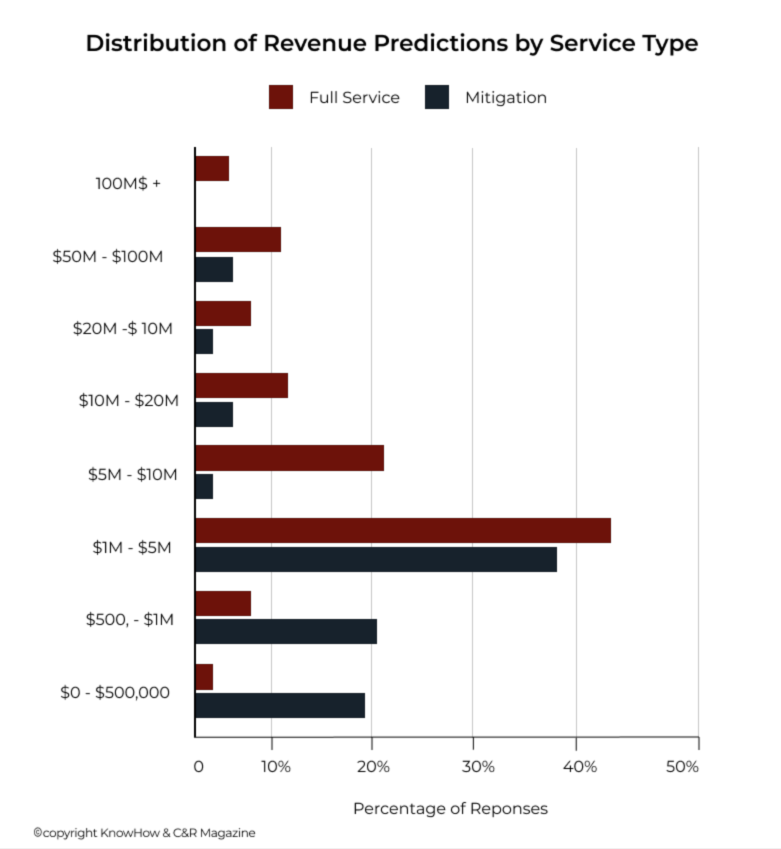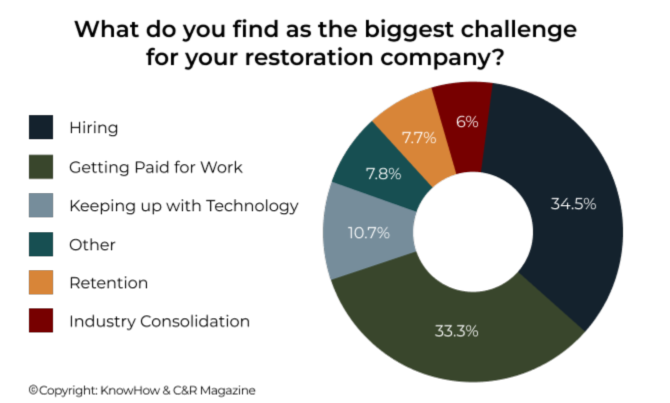The more things change, the more they stay the same. That certainly seems to be the case when it comes to the restoration industry. Last year, C&R and KnowHow conducted the first State of the Industry Report covering a variety of topics from top pains restorers face to how restorers make purchasing decisions to mergers and acquisitions and everything in between. This year, C&R and KnowHow followed up with another industry report covering the same topics and looking at trends in the industry compared to the last report.
There were many insightful trends on where opportunities are for restorers and how they can take advantage of them shared in this report. In this article, we’ll dive into our perspective on three of them: expanding service offerings, extending service areas and hiring, and getting paid.

It was clear in the State of the Industry Report that restorers want to, and should, diversify their service offerings and become full-service shops. Based on the report’s findings, full-service restoration businesses often out-earn mitigation-only businesses. However, expanding your services requires major cash flow considerations, a culture of strong operational tension, and a new playbook for your team.
To Dan Doud, CEO of OCS, the key to expanding your services to include reconstruction is resource allocation. Contractors wanting to grow need to take a look at their business operations and identify places where operational efficiency can be improved. Often, this can mean turning to specialized third-party companies like OCS to manage certain parts of their operations. When contractors turn their billing over to OCS, they can save time and increase their profits, setting them up for success when branching out into reconstruction.
More than 66% of restorers desire commercial work to be 50-75% of their work. However, only 27% currently have this mix. Clearly, there is demand from other restorers to expand into this revenue stream, but there are some challenges around doing so.
Commercial jobs tend to be riskier than residential jobs, especially from a cash flow standpoint. While commercial jobs are often bigger jobs with higher price tags, they’re also longer jobs, which often means waiting longer for a check.
“Having [OCS’s] level of expertise and professionalism to manage those [checks] can reduce some of the risks for contractors,” Cam Smith, COO of OCS, explains. One Claim advocates for our contractors, working hard to get an initial check during the job to bolster the contractor’s finances until they can get a final check when the job is complete.
Building new relationships, adjusting your internal operations, and meeting insurance requirements to operate with increased liability for commercial work all require time. “If you’ve outsourced to a third party like OCS, you’re freeing up capacity to go shift your business,” Dan says.
Many restoration companies are targeting growth & expansion, but with that comes the trade-off of larger overhead, multiple locations, and more miles logged. Currently, the vast majority of restoration companies (77.3%) provide coverage for their entire city and the surrounding area, but most have not gone fully State-wide.
Restorers looking to expand their service area will have the best chance for success when they optimize their resource allocation and cash flow, Dan says. This could look like adjusting your company’s internal structure or outsourcing collections to a third party like OCS.
 Hiring & Retention
Hiring & RetentionHiring is the biggest challenge for restorers, with 34.5% listing this as their biggest challenge. Retention is listed as the biggest challenge for 7.7% of restorers. Even with this challenge, 77.3% of restorers anticipate growth in staff over the next 12 months. In last year’s survey, we discovered it takes an average of 8+ weeks for new hires to be productive in their role.
Additionally, recruiting, training, and retaining administrative employees like collections team members often requires a different approach than doing the same for technicians and project managers. Contractors looking to expand their team will have more success when they approach hiring with this in mind.
Contractors who leave collections to OCS avoid the challenges associated with hiring an internal billing team. Instead, OCS takes full responsibility for recruiting and retaining skilled collections team members. “We… build up their process and content knowledge so that they are true experts at negotiating claims,” Dan says. By delegating this responsibility to OCS, contractors get to benefit from our expertise, all while saving time and money.
The data clearly indicates that increasing base compensation for technicians has an influence on the length of their tenure with the company. This means that companies will likely have to consider increasing their labor costs next year.
While some companies may hesitate to increase wages, it will likely be less expensive than dealing with high employee turnover. “Turnover averages a cost of half to two times the person’s salary,” Nicole Liesenfelt, Director of Human Resources at OCS, notes. To be in a good position to offer higher compensation, restoration companies need to maximize their cash flow.
Subcontracting certain responsibilities can save contractors some personnel costs. When contractors turn to OCS to manage their collections, they don’t have to foot the cost for the wage increases or turnover of collections staff.
Time to get paid is decreasing. On average, 75% of restorers are getting paid in 45 days or less, compared to 54% last year. The mix of business (residential vs. commercial) doesn’t appear to affect the time to get paid. Instead, the findings seem to imply that a company’s processes and intentionality surrounding collecting payments have a far greater influence on the time it takes to get paid.
“There’s getting paid fast, and there’s getting paid completely,” Cam points out. Often, carriers will send a very low first payment. Some restoration companies take the path of least resistance and settle for carriers’ initial low offer instead of taking the time to fight for full compensation.
Restoration contractors don’t have to sacrifice time for money when they work with OCS. Our billing advocates are experienced insurance negotiators who know the best ways to secure fair payments from carriers. If you’re tired of choosing between time and money, request a consultation with One Claim Solutions to see if we are a good fit for your billing needs.